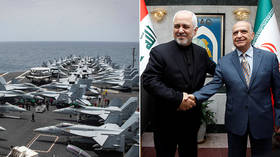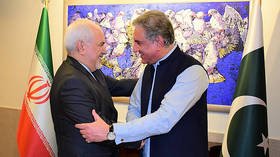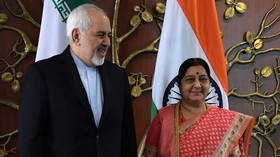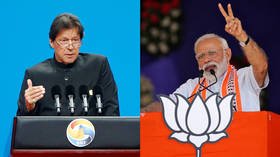As US ramps up military force, Iran shows leadership with regional diplomacy

When history of the present US-Iran stand-off in the Persian Gulf is written, future scholars may note how it was Tehran that saved the day from full-scale war by its responsible diplomatic outreach to regional neighbors.
This weekend saw the usual feckless American vacillations resulting in even more military power being deployed in the Middle East where US troops already number some 70,000.
President Donald Trump has dispatched more squadrons of fighter jets, warships and missiles which he says are for “protection” against alleged Iranian threats. He also signed off $7 billion in arms sales to Saudi Arabia citing “an emergency.” Tehran condemned the latest US force escalation as “highly dangerous.”
At the same time, by contrast, Iranian diplomats engaged in a regional tour calling on all countries to cooperate on maintaining mutual security. Iran’s foreign minister Mohammad Javad Zarif while visiting Iraq urged all Persian Gulf countries to form a non-aggression pact. Earlier, Zarif also took his message to Pakistan. Meanwhile, Iran’s Deputy Foreign Minister Abbas Araghchi is visiting Kuwait, Oman and Qatar this week proffering the same entente.
Also on rt.com Washington sanctions threaten Middle East security – Iranian Deputy FMThe diplomatic overtures from Iran could be a watershed development. Can nations that have previously seen bilateral relations with Iran distorted by Sunni-Shia religious tensions put aside sectarian divisions and work together to preserve peace in the region?
If they can rise to the occasion, the resulting solidarity would be a blow to Washington’s dominance in the Middle East, where the Americans have sought to isolate Iran from its neighbors with repeated and usually unfounded claims of “aggression” by Iran and “Shia proxies.” Essentially, divide-and-rule tactics.
A sign of the potential new regional cooperation was seen during Zarif’s visit to Iraq at the weekend. The Iraqi prime minister Adel Abdul Mahdi pointedly said that Iraq stood with Iran in the face of American military intimidation. Baghdad last week warned it would not allow US forces to use its territory for any attack on Iran.
The Iraqi leadership also stressed that Washington’s sanctions against Iran have damaged Iraq’s economy. It was further pointed out that economic development between the two neighboring countries is inevitable and cannot be stopped by US pressure on Baghdad to isolate Tehran.
Iraq shares close ties with Iran through its popular following of Shia Islam. But the cultural and political ties are much bigger than religion. Iran as far back as 2014 helped Iraq quell a threat to its national security from Al Qaeda-linked terror groups. Iran achieved this through support for various Shia militia groups. These popular militias have become an indispensable part of Iraq’s relatively restored security situation. Other regional countries have taken note of how Iran salvaged Iraq from chaos – chaos which the US invasion and a decade occupation of the country from 2003 largely unleashed.
Iran shares millennia of historical ties with other neighboring countries. The Sunni-Shia theological divide goes back to the earliest days of Islam in the 7th century. But it was only until relatively recently that the divide became a toxic sectarian schism often with internecine violence. For many Muslims, the sectarian dichotomy is lamentable and should be deplored, viewing all members of Islam as brothers and sisters, regardless of the formal Sunni or Shia identity. Middle East observers point out that the toxic sectarianism escalated following the Iranian revolution in 1979 when US forces were kicked out of Iran along with Washington’s puppet dictator, the Shah. As a way to roll back the Iranian revolution, it was Washington and its hardline Sunni client regime in Saudi Arabia that fomented the tensions and antipathies towards Shia Islam. The Wahhabi version of Islam held by Saudi rulers is distinct from other Sunni branches in that it vilifies the Shia as “infidels” who should be put to death. That’s partly why the American propaganda war against Iran found such a useful instrument with the Saudi autocrats.
However, despite the constant US-led propaganda to demonize Iran as a “terror sponsor,” regional relations have not been irreparably poisoned. Iran has, for example, maintained fairly good relations with Kuwait, Oman and Qatar. Iranian business and family ties have long meshed the societies in the Persian Gulf, with the notable exception of Saudi Arabia whose fundamentalist rulers and their Wahhabi cult-like beliefs view Iran as a nemesis.
The blockade by Saudi-led Gulf nations against Qatar that was launched in 2017 – and is ongoing albeit waning from ineffectiveness – was due to claims by the Saudi monarchs that Doha was “being too close to Iran.” The Trump administration at first fully backed the Saudi-led hostility towards Qatar in its knee-jerk mentality of confronting Iran. Though, the White House has since quietly advocated the Gulf nations to normalize relations, realizing that the economic impact of the Saudi-led blockade on Qatar has caused much disruption and is counterproductive.
That is a classic case of how American and Saudi obsession with Iran has only served to hamper regional economies and relations which is not in the actual interests of the region.
The Middle East region with its ancient historical knowledge must realize that centuries of common Islamic heritage transcend recent decades of sectarian conflict based on a contrived Sunni-Shia divide that has been inflamed for selfish geopolitical reasons. The countries of the region must surely realize by now that the destabilizing imposter is not Iran – which has bestowed millennia of benign influence – but rather it is Washington.
The devastation and trauma that Washington has inflicted on the Middle East is there for everyone to see. From its illegal wars and invasions, to inflaming of sectarian tensions and sponsoring of terrorist cults to act as cat’s paws for regime change. Not to mention the despicable suppression of Palestinian national rights by backing an illegally occupying Israeli regime with decades of massive military support and duplicitous political kowtowing.
Syria – a nation of multi-faiths and cultures – was almost destroyed by the US and its colluding sectarian client regimes. It was Iran, along with Russia, which intervened to salvage Syria from impending doom. Iran achieved a similar mission in Iraq.
That’s why Iran’s calls now for regional cooperation and solidarity between all nations – regardless of Sunni or Shia labels – may be the saving initiative in the present dangerous stand-off with the US. If enough countries join the Iraq-Iran anti-war axis that emerged this week, then American ambitions for inciting conflict may be decisively checked.
Iraq and Iran – two countries which went to war in the 1980s largely incited by American intrigues to vanquish the Iranian revolution – are now demonstrating a potential new reality of solidarity in the Middle East.
Furthermore, a newfound regional solidarity based not on partisan religious affiliation, but rather on shared neighborly interests could be a positive departure from pernicious American interference that has long marred the Middle East.
Like this story? Share it with a friend!
The statements, views and opinions expressed in this column are solely those of the author and do not necessarily represent those of RT.

















